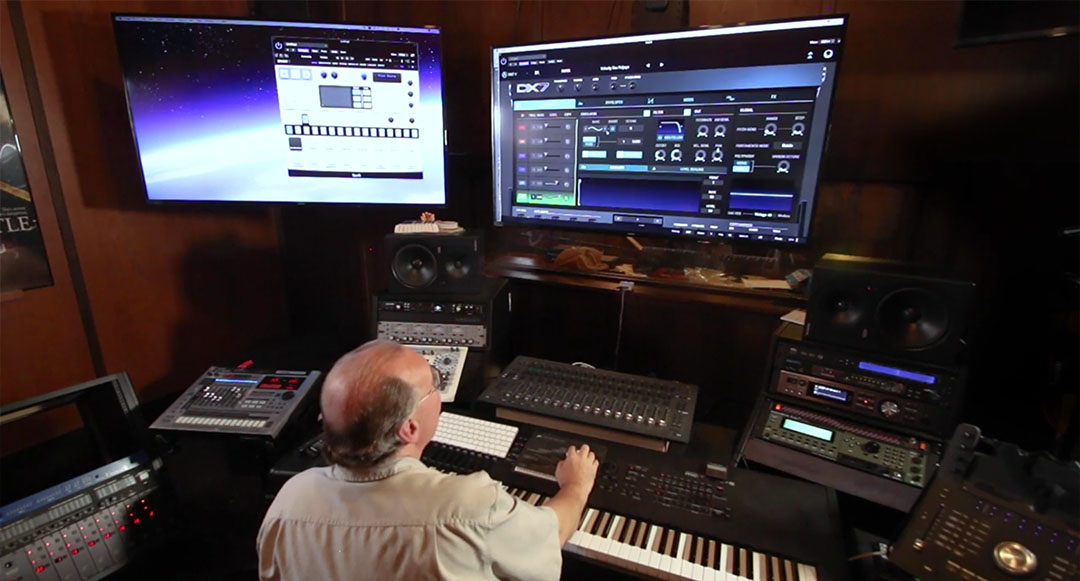Larry Hopkins
Mastering FM
synthesis
“This is a wonderful time to be a sound designer”
As long-time Arturia fans will know, many of our interviews often feature big artists or rising stars, often household names or on their way to becoming one, but sometimes the real heroes aren’t the stars of music videos, films and TV series, they’re the people that make it all happen behind the scenes.
We recently had the honor of sitting down with Larry Hopkins to chat about his long, inspiring career in the music industry, and how he’s shaped what we hear for some of the biggest artists, best movies, and most iconic instruments.
There’s a good chance Larry’s name might be new to you, but we’ve known him for a very long time. In fact, he was one of our first sound designers! He now works for Technicolor as a foley artist, engineer, and sound designer. You’ll have definitely heard his masterful work before, as he’s been involved in over 600 TV shows and films, including Lost, Minority Report, Finding Nemo, Breaking Bad, The Vampire Diaries, The Originals, Desperate Housewives, Grey’s Anatomy, and The Dark Knight.

A passion
for sound
Hopkins started his love of music early. Born into a family of string players, he started learning violin at age 4. As he grew, he would be inspired by the pioneering synth-work of (then) Wendy Carlos and Keith Emerson, and was blown away when he had his first hands-on synth experience with an Emu and a Moog Modular system.
As his synth-programming abilities grey and his musical vocabulary expanded, he began to master many important synths of the time, many of which have been recreated in Arturia’s V Collection. The Prophet V, Matrix-12, the ARP Odyssey, Synclavier, and during the 1980s he was one of the first to master the dark arts of FM synth programming, and became one of the go-to FM sound designers in the music, film, and TV industries. He even helped spec and design sounds for the synth chip in the Saturn, Sega’s 1994 games console.
His skills aren’t all technical, however. Larry is a very talented musician, and he had many amazing opportunities to learn from the best, including the Rolling Stones, and Ray Charles when he worked as a live keyboard technician.
“After rehearsals were done, often it would just be me and Ray (Charles) in the studio, and he would teach me gospel… and I’d show him a voicing or a lick. Just the two of us in the studio, that was a very wonderful time for me.”
For his work on recent vampire-themed shows, he’s been enjoying creating and combining the variety of the gory sounds involved: neck bites, heart-pulls, breaking bones and walking through entrails, certainly a change from Finding Nemo!
The FM
Master
“For the first time one keyboard could do electric pianos, clavs, comping synth pads…”
The DX-7 became his weapon of choice for most Despite being a vintage synth and notoriously tricky to program, Hopkins keeps coming back to the DX-7 for its powerful sound-design scope and rich timbre. He even used the original DX-7 for Minority Report, designing sounds to match descriptions in the score for John Williams.
“Now the classic synths in my studio are really just for looks!”
After rehearsals were done, often it would just be me and Ray (Charles) in the studio, and he would teach me gospel… and I’d show him a voicing or a lick. Just the two of us in the studio, that was a very wonderful time for me.
Since the release of Arturia’s DX7 V, Hopkins has thoroughly enjoyed the new sonic potential in the software reincarnation, opening up whole new avenues of experimentation that simply weren’t available in the original due to the limitations of the hardware. He loved it so much, he even created a dedicated sound bank of some of his best-know signature FM sounds for users all around the world to enjoy.
Larry Hopkins
Signature
Compatible with DX7 V, and also Analog Lab.
“There’s a number of sounds in the library that are a little more analog synth-like, that you might expect from an Oberheim® or a Moog.”
“Don’t forget to move the mod-wheel up! There’s our wonderful four-bus effects. For example, we can make this huge reverb, chorus bell sound with the mod-wheel up, and a nice clean bell sound with it down.”
“The Arturia plug-ins have the true nature of the original units. I have my hands on both… but of course, back in those days you’d often be playing one note at a time (on things like the ARP 2600), and they couldn’t remember sounds. Now you have these great sounds, but with polyphony!”
“It makes it so much easier to do what I did back in the day, and go in and create custom sounds.”
“This is a wonderful time to be a sound designer, a musician, a composer... my new studio would have cost a couple of million dollars in the 80s, but now I can create my dream setup for a fraction of the cost.”
Get preset bank Larry Hopkins Signature now!
To experience Larry Hopkins’ work, visit the cinema and see a blockbuster movie, or watch an award-winning TV series. There’s a good chance he’s been involved!
